Do you often find yourself throwing away or composting the remnants of fruits and vegetables after cooking or preparing a meal? While many people think of food scraps — such as mushroom stems, onion bottoms, and the tops of pineapples — as waste (or future fertilizer), these items can have a second life. You can take many different types of fruit and vegetable scraps and regrow food from the leftover bottoms, stems, seeds or pits, tops, or pieces.
Food waste is a monumental problem for people and the planet, losing valuable calories that are directly linked to world hunger, and contributing to greenhouse gas emissions as decomposing organic waste releases methane gas. But growing food from scraps helps reduce food waste while also providing a relatively easy and economical way to supplement your diet with more fresh produce. Even if you don’t have a particularly green thumb, regrowing vegetables and fruit takes minimal effort and, in some cases, doesn’t even require soil!
In this article, you’ll learn how to regrow vegetables and fruit from scraps to reduce waste, save money, and build self-sufficiency.
Can You Regrow Anything from Scraps?

If the idea of regrowing vegetables and fruit from scraps excites you, that’s great! But before you start trying to put any old fruit or vegetable scrap in soil or water, there are some things you need to know.
Not all scraps from produce will produce a new plant or growth. Typically, you need a stem or other piece of a plant that can grow roots in order for it to start growing again. You can also grow some fruits and vegetables from leftover seeds or pits.
But some produce purchased from a grocery store may not grow from its seeds or other scraps at all. Fruits and vegetables found in grocery stores may be subject to irradiation, which is done to prevent sprouting or delay ripening. Irradiation may prevent a plant from rooting or make seeds sterile.
Also, if the food was picked before it was ripe, the seeds may have not fully matured and may not be viable. You can test seeds by placing them in water and seeing if they float or sink (you want them to sink) or by performing a germination test.
How to Regrow 12 Fruits or Vegetables from Scraps
Want to try your hand at regrowing produce from scraps? These 12 foods are a good place to start. For the majority of them, all you need are glass jars or other upcycled containers, water, and a little bit of soil.
1. Tomatoes
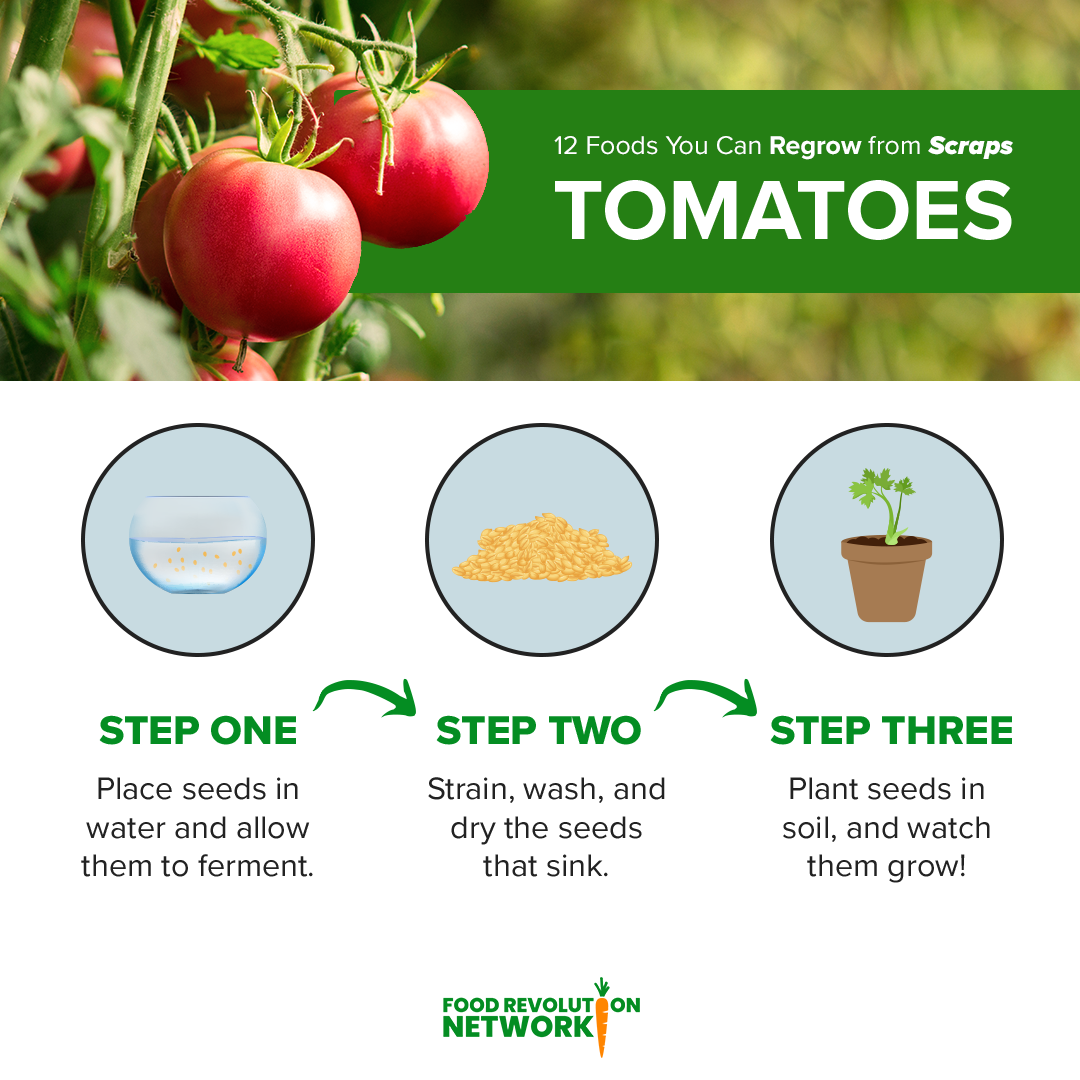
Tomatoes are often cut and deseeded for recipes. Instead of composting their messy insides, try saving the seeds. By placing seeds in water and allowing them to ferment, you will break down seed coats and kill off many of the germs that may prevent the seeds from starting. When the seeds sink and separate from the pulp, you can strain, wash, and dry the seeds.
Here’s a video of this process from GrowVeg:
https://www.youtube.com/watch?v=qbVcHLpHxKg
Next, plant the dried seeds in a pot or upcycled container filled with potting soil. Once the sprouts are a few inches tall, transplant them outdoors. Be sure to plant the tomatoes in a sunny area and water a few times a week.
How to use regrown tomatoes:
Tomatoes are extremely versatile and can be used in a number of different cuisines such as Mexican, Italian, and American.
Use regrown tomatoes in sauces, salads, pasta dishes, casseroles, and on top of veggie burgers, tacos, and sandwiches.
Check out our article on how to grow tomatoes for more growing tips and our article on tomato benefits, downsides, and uses.
2. Basil
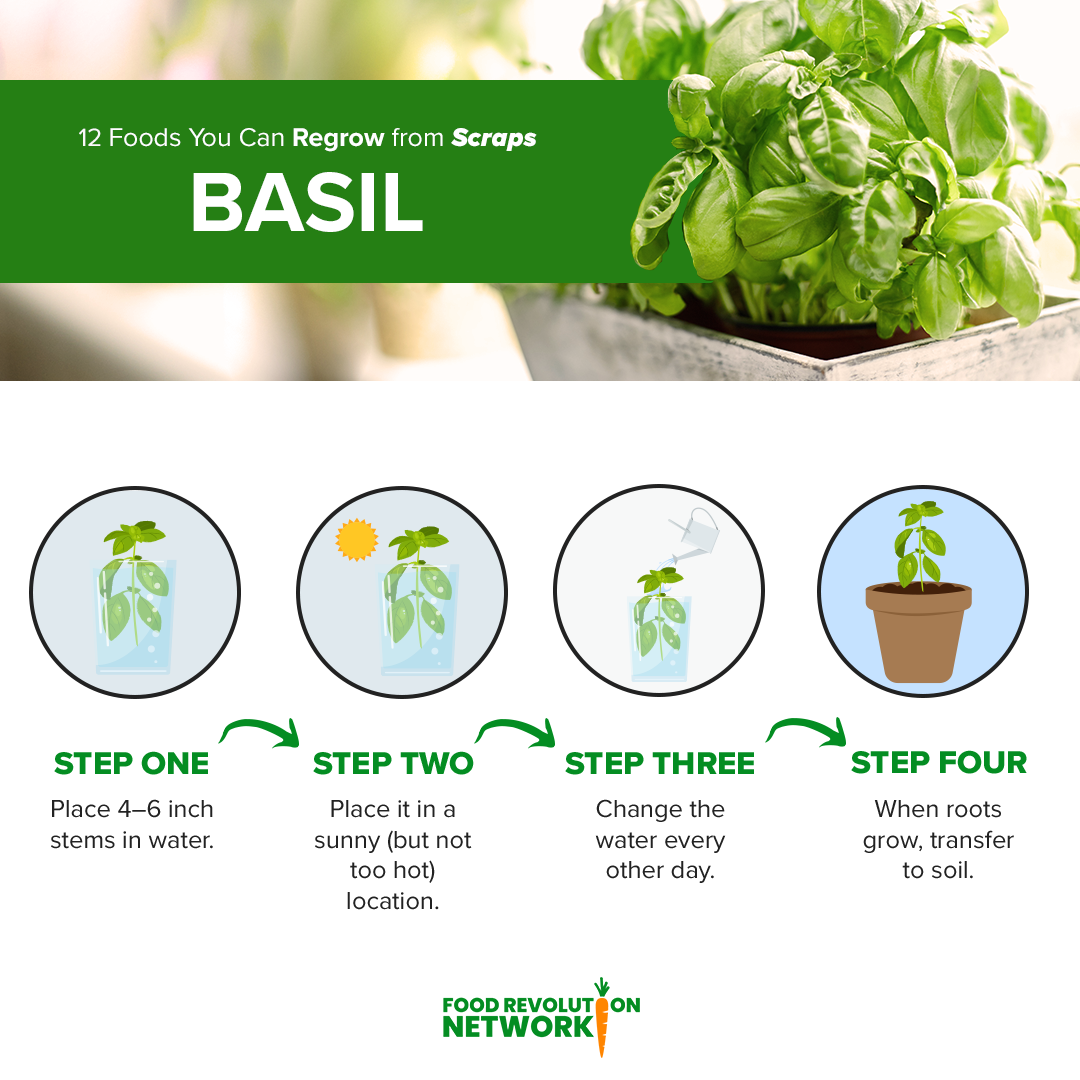
To regrow basil from store-bought plants, select a four- to six-inch piece and cut about one inch under where a leaf is growing. Then, you’ll want to strip any leaves that are at the bottom of your stem to prevent them from becoming submerged in water and rotting. Put the stem in a jar of water and place it in a sunny (but not too hot) location. Change the water every other day. You’ll soon notice new roots forming along the stem.
When the basil roots grow to about two inches in length, plant the stems in a pot or upcycled container. Keep the pot in an area that gets at least six hours of sunshine each day, and water the basil plant regularly. Harvest leaves when the plants grow to at least six inches tall and produce six to eight leaves per stem.
How to use regrown basil:
Genovese basil is typically used in Italian dishes. But other common varieties are Thai basil, which can be used in Asian cuisines, and holy basil, which is a medicinal herb.
Use regrown basil leaves in pasta and noodle dishes, sauces, rice bowls and stir-fries, or dried and brewed as a tea.
Our guide to herbs and spices has ideas on how to use fresh and dried herbs like basil in your meals.
3. Strawberries
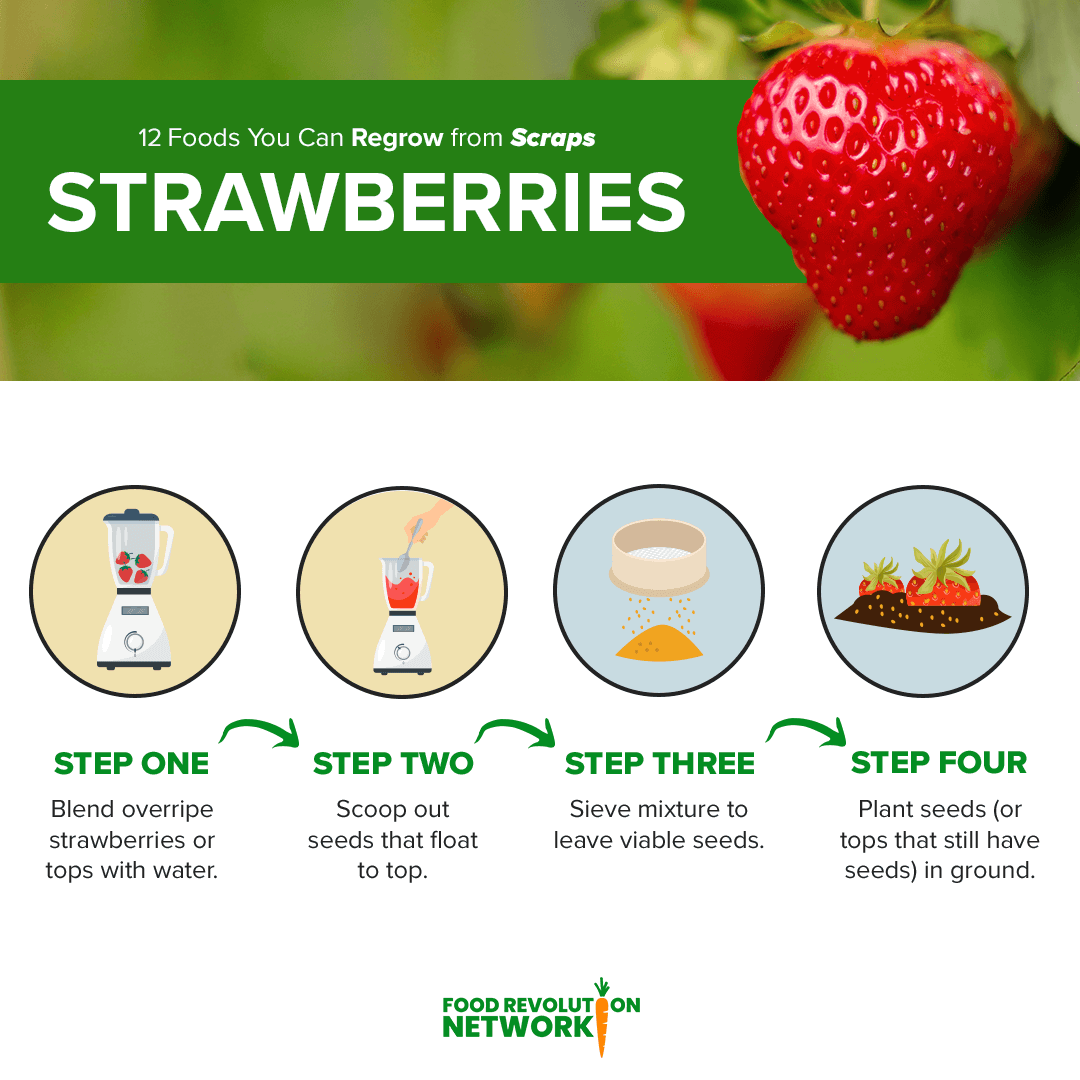
First off, it’s best to use locally grown strawberries since not all varieties will grow across all climates. Secondly, you’ll likely want to use organic strawberries when possible, since they’re one of the most pesticide-contaminated produce items.
To reuse your strawberry scraps, put the overripe, whole strawberries, or strawberry tops, in a blender with water and blend for 15–20 seconds. Leave the mixture to settle. The seeds that won’t germinate will float to the top, so you can skim those off and discard them. Then, pour the remaining strawberry mixture through a sieve to leave just the viable seeds. Plant the seeds as you would normally to grow strawberry plants in your climate.
You can also try planting strawberry tops or slices directly in the ground, as long as some of the seeds are still intact.
How to use regrown strawberries:
Strawberry is native to the Americas and is primarily used in American, French, and English desserts.
Strawberries can be eaten on their own, preserved as jams, or used in baked goods, salads, and smoothies.
Learn more about strawberries and other berries and discover their health benefits and uses.
4. Celery
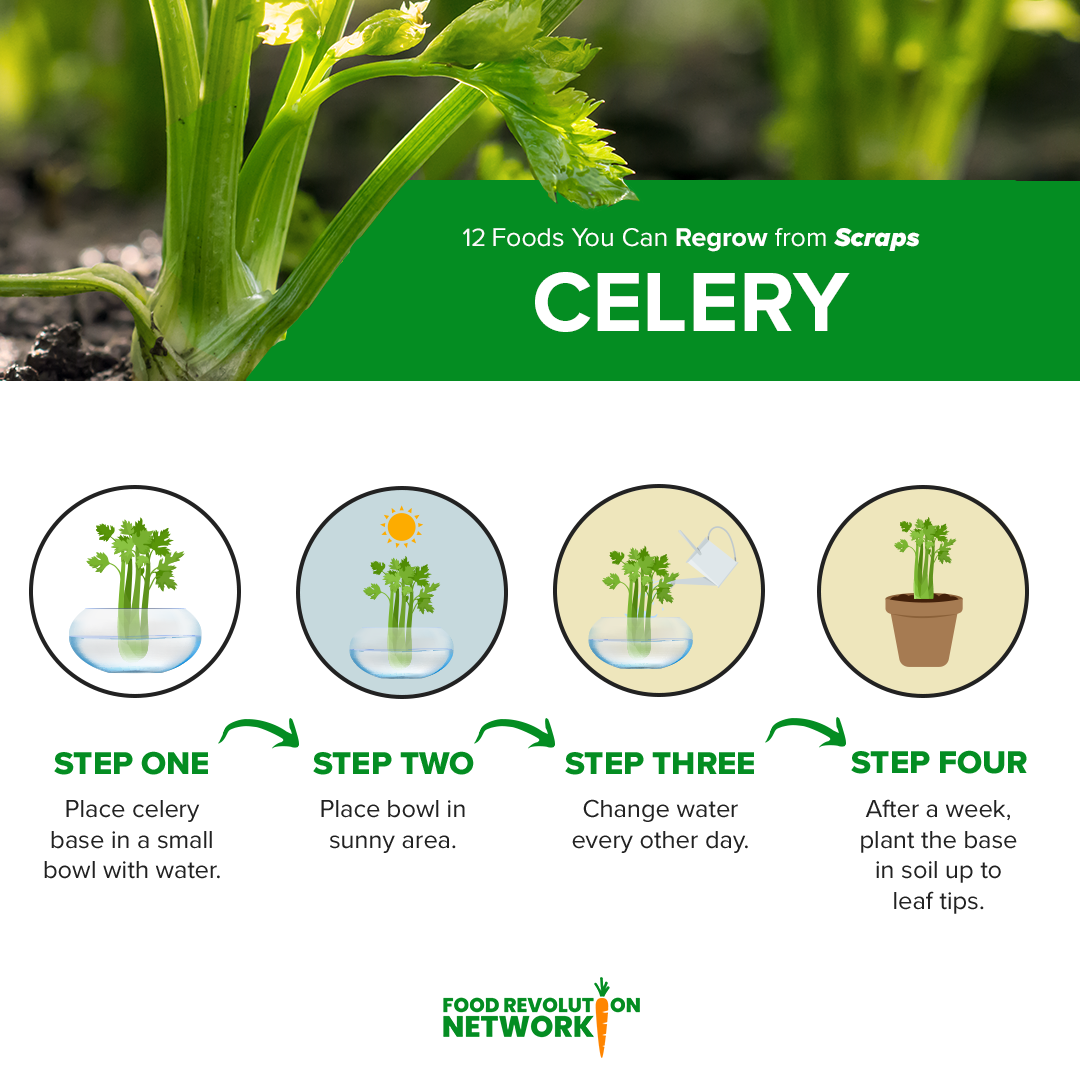
To regrow celery stalks, you’ll want to keep about two inches of the butt end of the vegetable. Rinse off the base and place it in a small bowl or glass. Fill the container with warm water and place it in a sunny area. After changing the water every other day, you should start to see new growth around day five. Celery leaves will regenerate from the base, as well as a few small stalks.
After about a week, you can plant the celery base in soil, making sure to leave the leaf tips and stalks uncovered. As celery is mostly water, you’ll want to keep the plant nice and moist. You can start harvesting as soon as your celery plant has at least 10 stalks, and they will continue to grow throughout the season.
How to use regrown celery:
Celery is popular in French and Cajun American cuisine. Leaf celery is also used in Thai and Chinese food.
Eat celery on its own or use it in soups, stews, chilies, salads, stir-fries, and to make celery juice.
Check out our article on how to grow celery for more tips and a cheat sheet.
5. Carrots
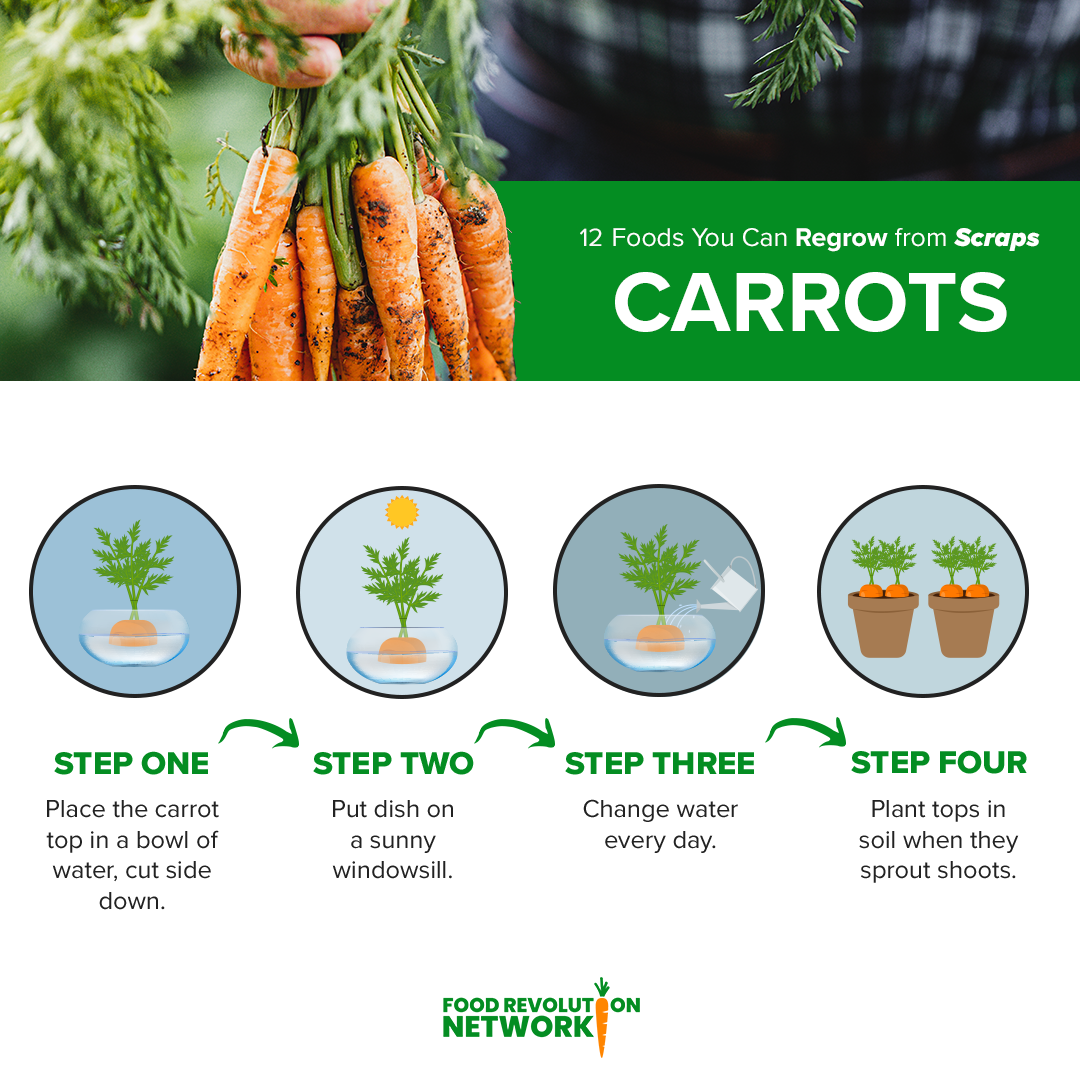
While you can’t regrow a full carrot from scraps, you can regrow and use carrot greens. Instead of defaulting to tossing carrot tops and greens in the compost, give them a second life!
Cut off the top of the carrot, and the existing carrot greens if they’re still intact. To regrow carrot greens, it’s best if you have a little bit of green stem still attached to the top. Place the carrot top or tops in a bowl, cut side down. Fill the bowl with about an inch of water so the top is halfway covered. Place the dish on a sunny windowsill, and change the water every day.
The carrot pieces will eventually sprout green shoots on the top and roots on the bottom. When they do, you can plant the tops in soil, careful not to cover the shoots. Harvest the greens to taste. (Some people prefer the baby greens; others prefer them fully grown.)
How to use regrown carrot greens:
Carrots and their greens are used worldwide and are popular in French, Middle Eastern, Indian, American, and Japanese cuisines.
Enjoy carrot greens in salads, smoothies, sauces, and stir-fries, and as a side dish.
Find out what’s so great about carrots in our in-depth article.
6. Ginger
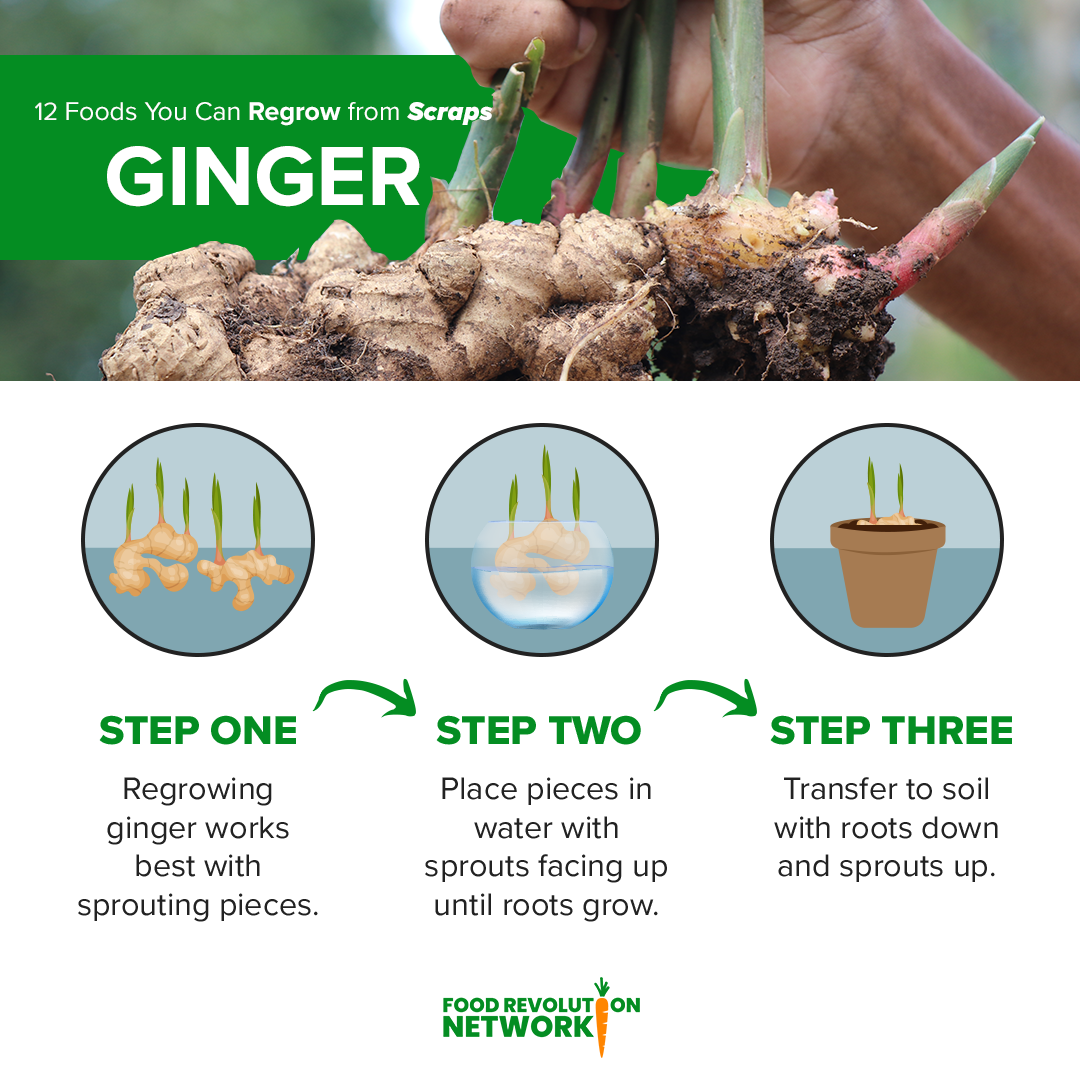
Ginger is a valuable spice for its health benefits and culinary uses. But as it’s so potent, you often only need a small piece for a recipe, leaving the rest to go to waste. Instead of throwing away or composting the leftover ginger, you can regrow the root and replant it, harvesting only what you need when you need it.
If you’ve had a ginger root for a while, you may start seeing little sprouts start to show. These are prime regrowing pieces to use. To regrow ginger from scraps, cut off one of these sprouted pieces and place it in water until roots start to grow. Once you have roots, place the piece of ginger in potting soil with the roots facing down and the sprouts or shoots pointing up. The ginger piece will produce new roots or rhizomes, which you can harvest in full or just remove a piece at a time.
How to use regrown ginger:
Ginger is often used in Asian cuisines such as Japanese, Indian, Indonesian, and Thai. It’s also used in baked goods across Europe and the US.
Use ginger as an ingredient in sauces, dressings, soups and stews, noodle dishes, rice bowls, stir-fries, and in teas, juices, and mocktails.
Learn more about the health benefits and uses of ginger.
7. Green Onions
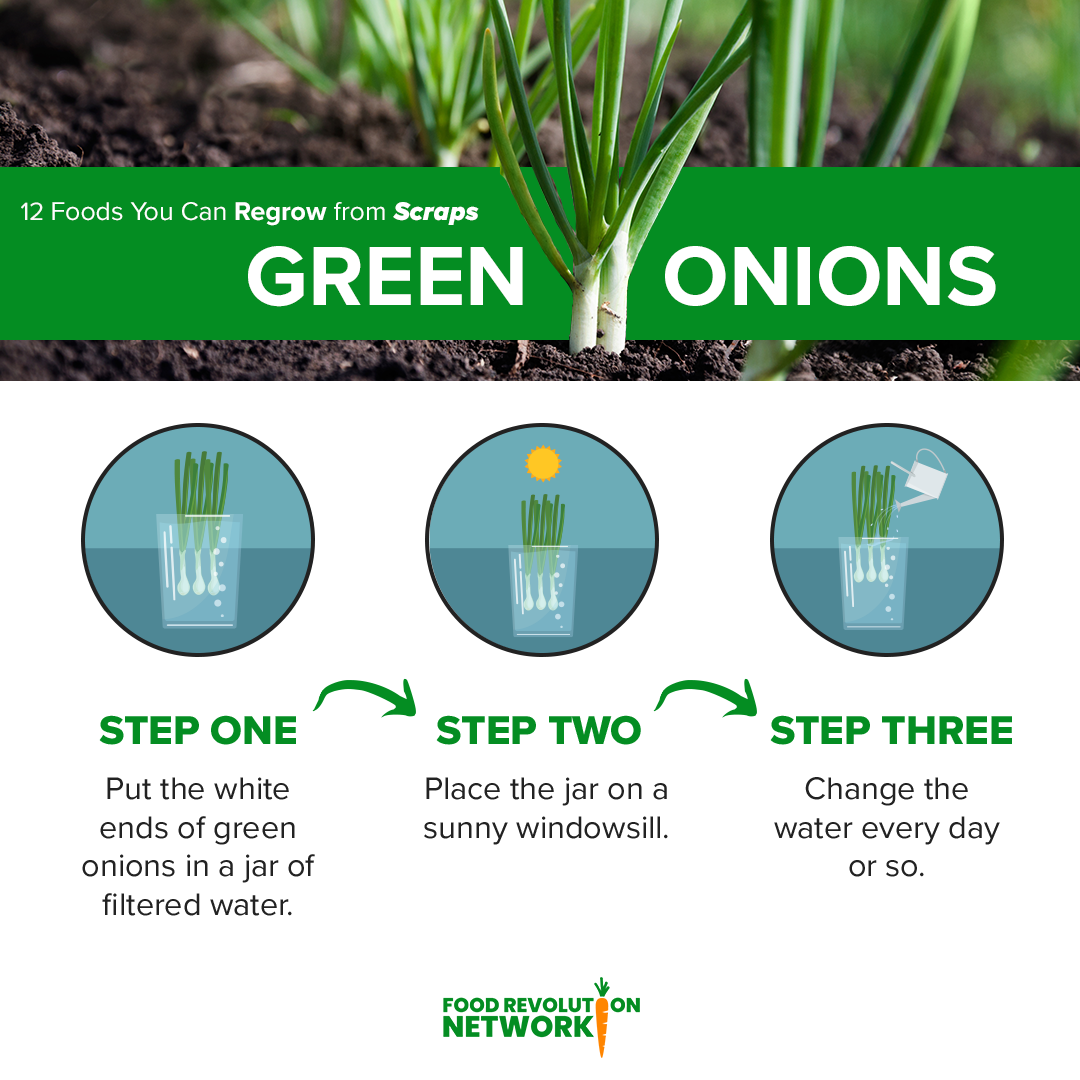
Green onions are one of the easiest foods you can regrow from scraps because they often still have bits of the roots attached when you buy them.
Save the white ends of your green onions and put them in a jar of filtered water. Place the jar on a sunny windowsill and change the water every day or so. In about a week, you should have new green onions to add to your supper.
You may want to transplant the green onions into soil once the roots have grown longer. Harvest the green ends when fully grown — just make sure to leave the roots in the water or soil if you want your plant to keep producing.
How to use regrown green onions:
Green onions are another versatile veggie that’s also used as an herb or topping. Use it in Mexican, Chinese, Korean, and Vietnamese food, among others.
Try green onions in savory pancakes or as a topping for dips, soups, stir-fries, rice bowls, and noodle dishes.
8. Mushrooms
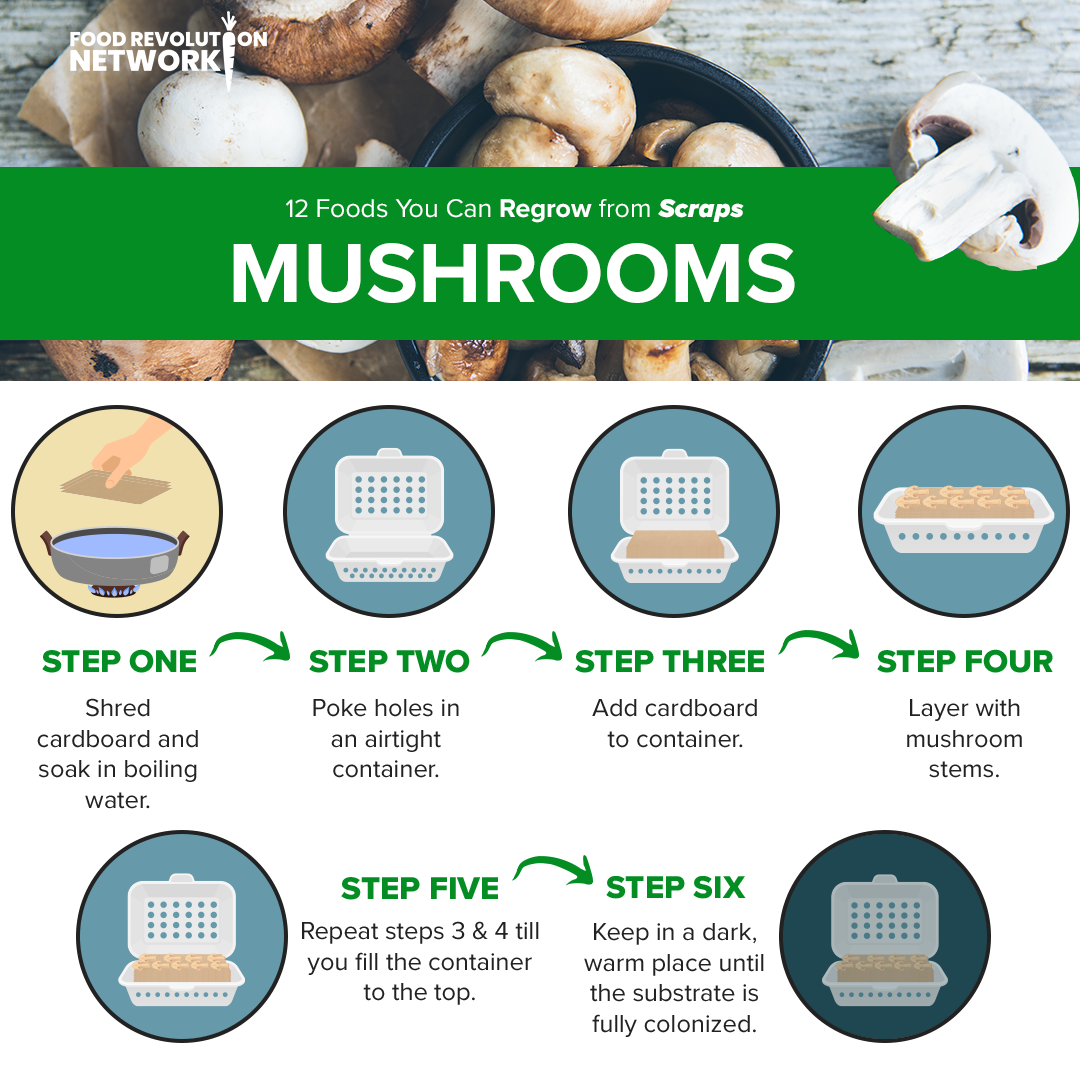
Be a fun-guy or gal and grow your own mushrooms from scraps. Mushrooms are one of the more complex (and expensive) produce items to grow, so this is one way to do it if you don’t have access to mushroom spawn. You can grow white button mushrooms in this way as well as oysters.
While you can eat both the caps and stalks of a mushroom, some people choose to only use the caps in recipes. But there’s no reason to let those stalks go to waste! You can combine mushroom stems with wet cardboard substrate in an airtight container to create your own mushroom spawn. This guide by GroCycle gives you step-by-step instructions on how to grow mushrooms with the stem butt method, as well as common problems you may encounter.
How to use regrown mushrooms:
Fungi exist on every continent and can be found in almost every type of culinary fare. Chinese, Italian, Japanese, French, and Nordic cuisines are all mushroom-loving cuisines.
Use mushrooms in soups, pasta dishes, grain bowls, stir-fries, and sauces, stuffed as appetizers, and on toast.
Growing mushrooms, even from scraps, is not an easy task for beginners. But if you want to give it a try, the health benefits of mushrooms are pretty substantial.
9. Onion
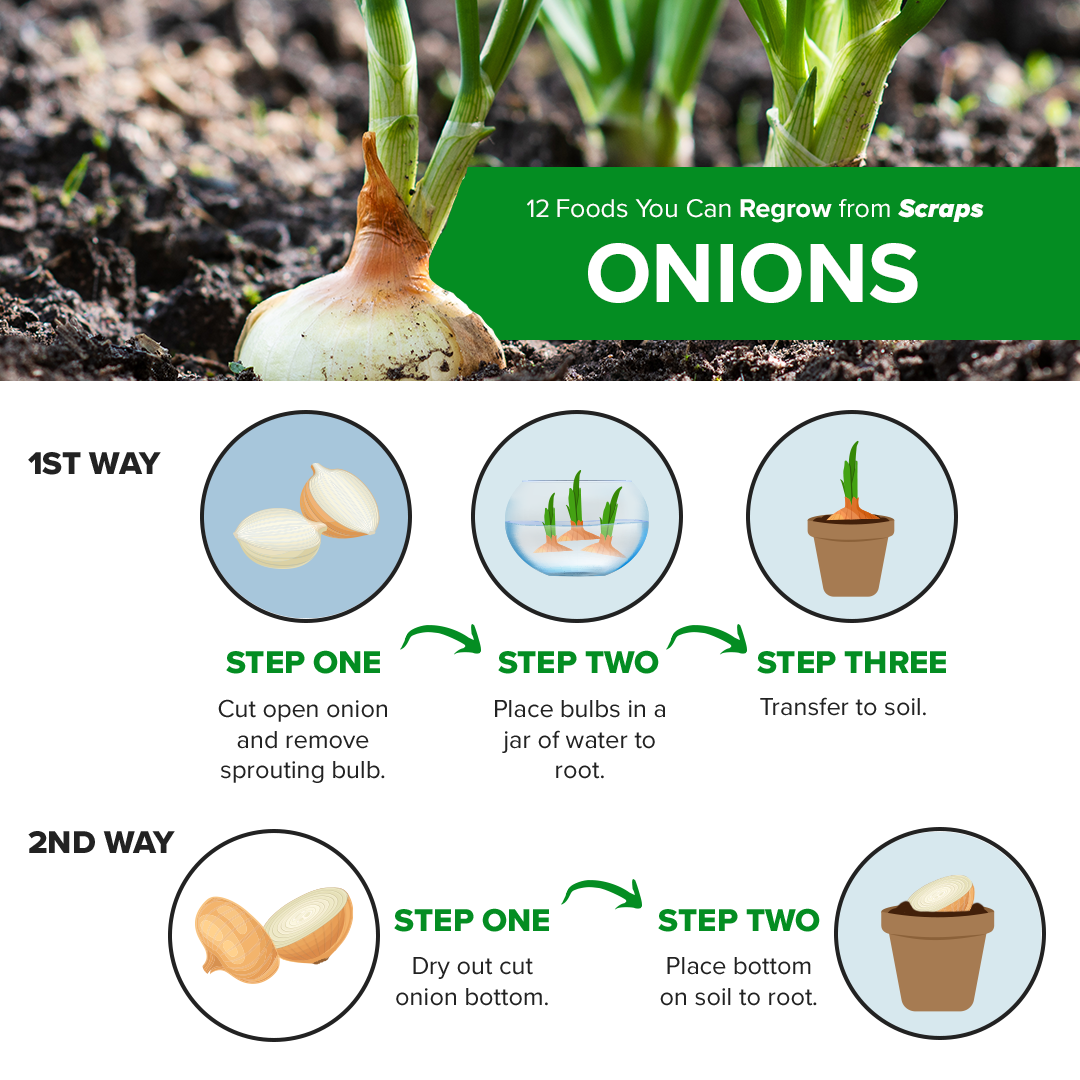
There are two different ways to regrow onions, depending on what scraps you’re working with.
If you have onions that have been sitting around for a while and have started to sprout green stalks, instead of cutting off the stalks, you can use them to grow new onion plants. The stalks have formed from bulbs inside the onions, so you just need to cut open the onions and remove the bulbs with the stalks attached. Place the bulbs in a jar of water to allow them to root and then transfer them into soil.
The other way to grow onions is from the discarded bottoms that are cut off when you slice into an onion. You want the calloused-over piece that may still have some stringy pieces of dried root attached. Let the cut bottom dry for a couple of days and then place it directly into soil. As the onion grows, you can harvest the green shoots or just wait for the onion to form underground into a full bulb before harvesting.
How to use regrown onions:
Yellow, white, and red onions are widely used vegetables. French, Ethiopian, Indian, Russian, and many South American cuisines use onions in various dishes.
Try onions cooked in soups, stews, curries, chilies, sauces, dips, and casseroles, or raw in salsas and salads, or on veggie burgers and tacos.
Learn more about the disease-fighting superpowers of alliums like onion.
10. Pineapple
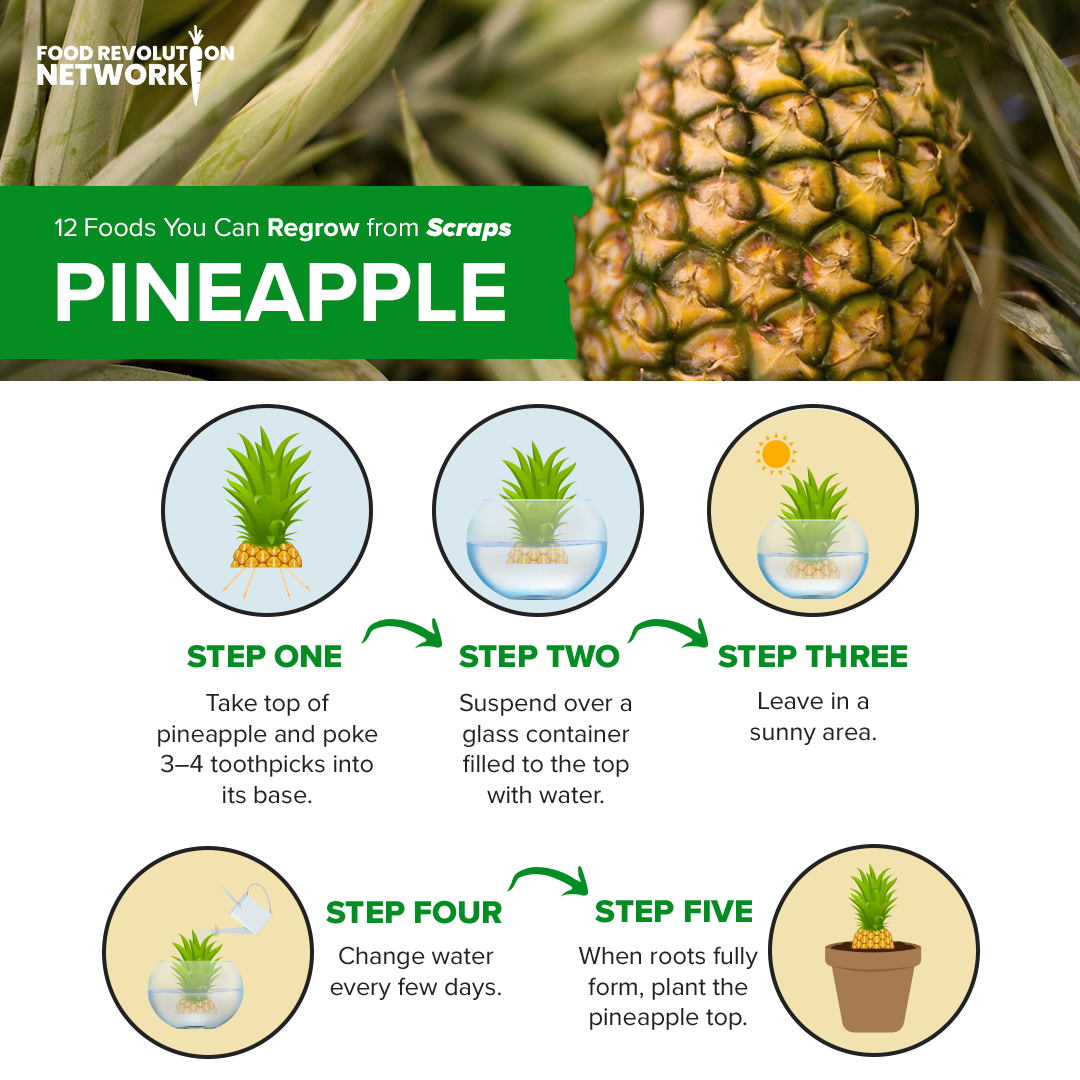
While it can take up to two years for a replanted pineapple top to bear fruit, the satisfaction of growing your own pineapple is well worth the wait.
To regrow a pineapple from scraps, remove the top of the pineapple, ideally by twisting it off (doing so will preserve the parts needed for regrowth). Peel back any leaves around the base so the bottom layers are exposed. And cut off just the tip of the base, being sure to remove any excess fruit.
Next, poke three or four toothpicks into the pineapple base right above the area where you peeled back the leaves. Use the toothpicks to suspend the pineapple top over a glass container. Add enough water to the container to cover the base of the pineapple top. Leave your suspended pineapple top in a sunny area, change the water every few days, and watch for roots to grow.
In about a week, roots should begin to form and the green leaves should be longer and wider. When the roots fully form, plant the pineapple top in a pot (or directly in the ground if you live in a warm climate). Make sure it’s exposed to plenty of sunlight, and water it regularly.
How to use regrown pineapples:
Pineapples grow in the tropics and are associated with cuisines from warm climates, such as Hawaiian, Indian, Malaysian, Thai, and Caribbean cuisines.
Eat pineapple on its own, in fruit salads, mocktails, smoothies and smoothie bowls, stir-fries and rice bowls, salsas, curries, and even on pizza if you dare!
Learn more about pineapple benefits, downsides, and uses.
11. Potatoes
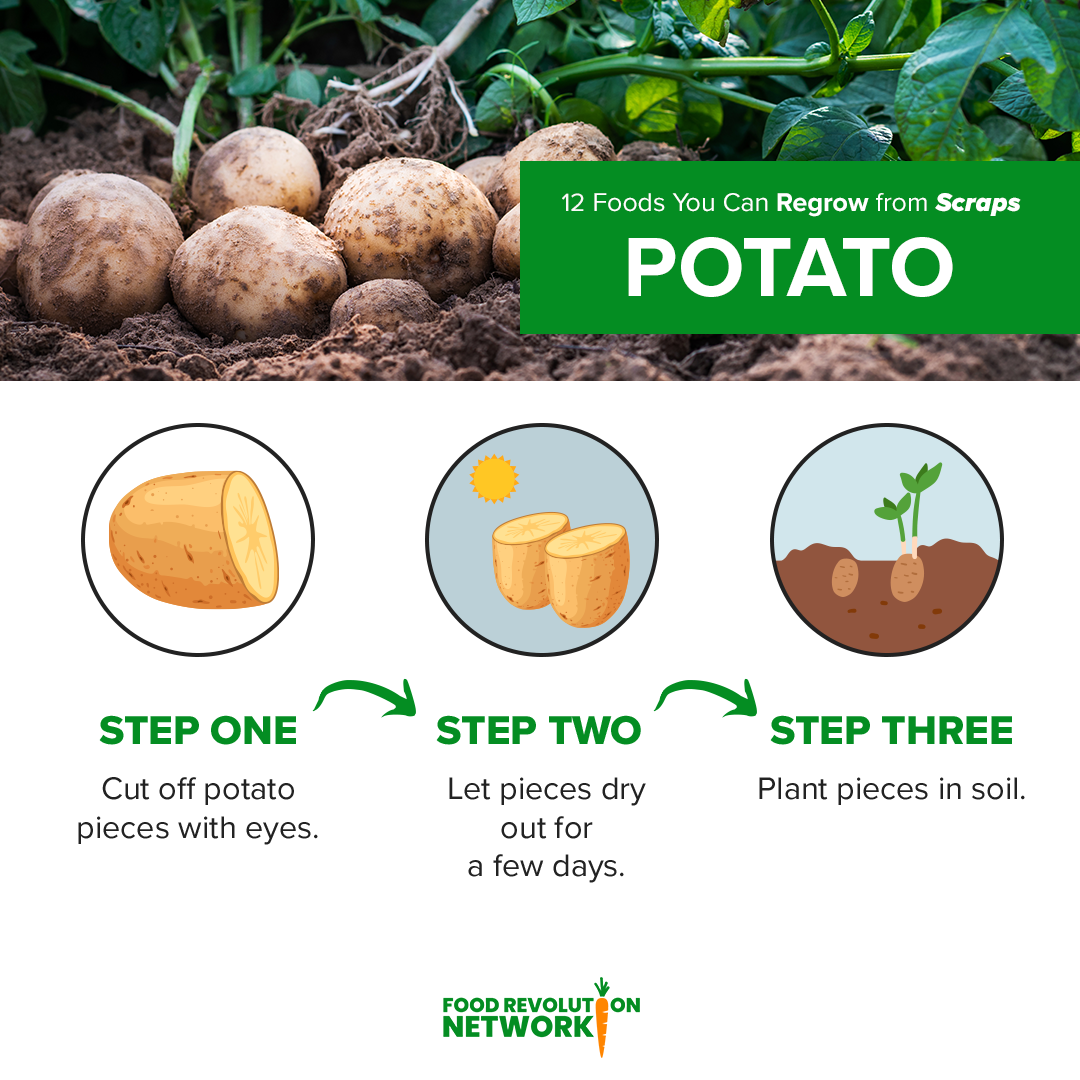
To grow your own potatoes from scraps, it’s best to use pieces that have eyes (red or white bumps), which is where they sprout from. It’s even better if the eyes have already started to sprout. If they have, that means the potatoes have not been irradiated, which, as was mentioned earlier in this article, can prevent new growth.
Cut the potato into pieces, making sure each piece has at least one to two eyes. Let the pieces sit at room temperature overnight or for a few days until they’re dry to the touch. Once the potato halves are dry, plant them about one foot apart in eight inches of soil. Or you can also plant the pieces in five-gallon buckets. After a few months, the potatoes will be ready to harvest and use in recipes.
How to use regrown potatoes:
Potatoes are a popular vegetable used in Russian, Indian, Irish, German, and American dishes, among others.
Avoid frying potatoes and instead, bake, boil, or steam them. Use in stews, curries, casseroles, or as a side dish.
Discover if potatoes are really healthy or not, in our in-depth article.
12. Lettuce
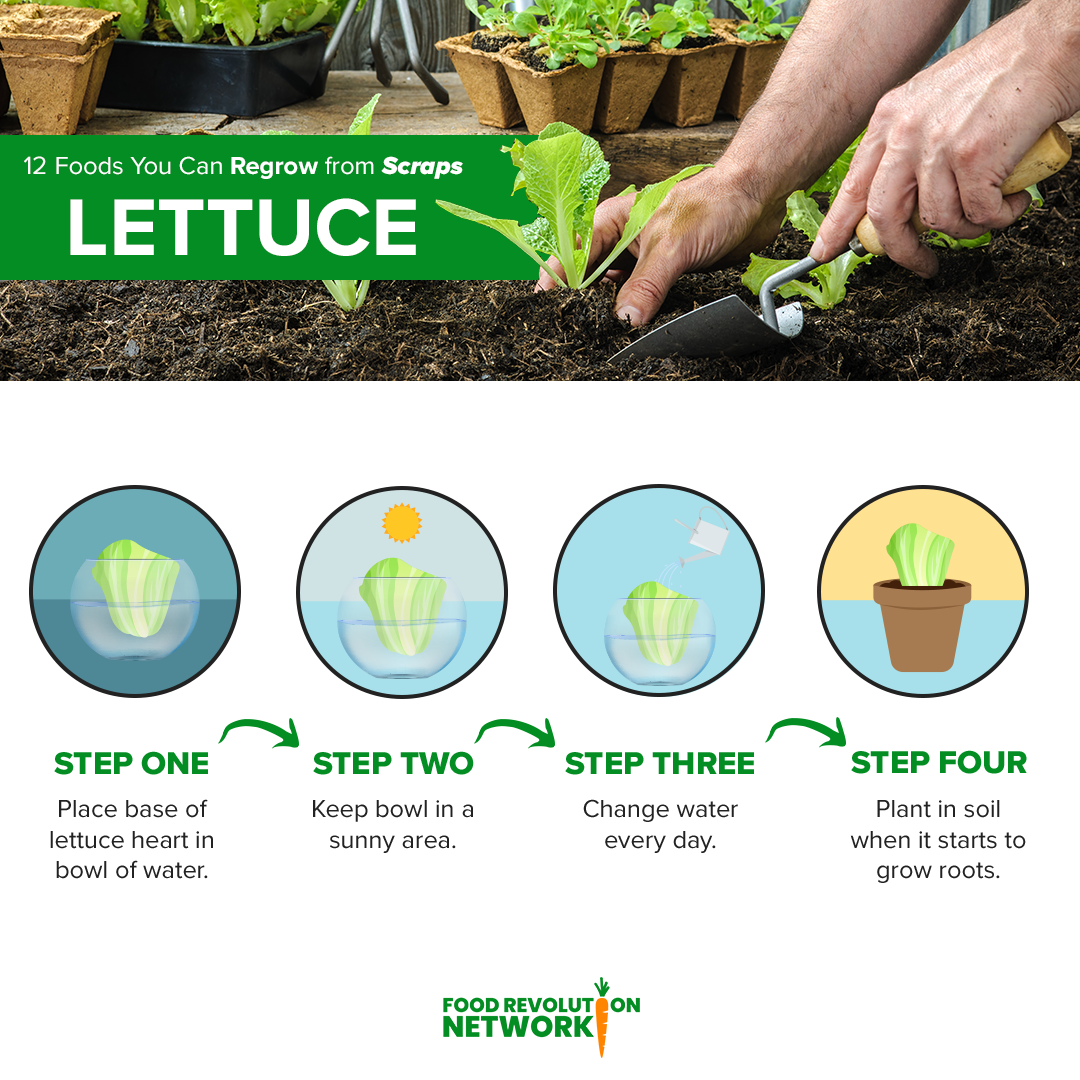
Like celery, you can also save the base of a romaine heart and place it in water. After a few days, you’ll start to see new leaves growing from the middle of the base. Keep the bowl in a sunny area and change the water every day.
Plant the lettuce directly in soil once it grows roots, or you can continue to grow it in water. However, it may not produce a full head of lettuce this way. If you like the taste of baby greens, you can pinch off the outer leaves as the lettuce grows. Otherwise, harvest romaine leaves when they’re around six to eight inches tall.
How to use regrown lettuce:
Lettuce is popular in American, Vietnamese, Italian, Chinese, and Mexican cuisine.
Lettuce is mostly eaten raw. Use it in salads, smoothies, noodle dishes, tacos, and on sandwiches and veggie burgers.
Find out more about why you shouldn’t underestimate the benefits lettuce has to offer.
Get Growing with Food Scraps!
With a little preparation and luck, you can regrow the 12 different fruits and vegetables in this article, including basil, pineapple, celery, and more. Regrowing produce from scraps is a great way to reduce food waste and save money on groceries.
And although it’s not possible to regrow all fruits and vegetables from scraps, especially if they were purchased from a grocery store, you can experiment with the various types of produce in this article to see what will grow for you.
As the saying goes, one person’s trash is another person’s treasure. But by reusing your food scraps regularly, you can avoid them ever becoming trash in the first place. It’s a win-win for everyone! And that’s something we can all treasure.
Tell us in the comments:
-
Have you ever tried regrowing food from scraps?
-
How do you reuse food scraps in your home?
-
What’s your favorite way to reduce food waste?
Featured Image: iStock.com/elenabs




